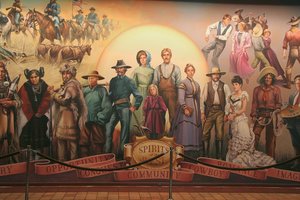By Rodolfo F. Acuña
LatinaLista
Curators defend their institutional efforts toward historical accuracy – and some do make an effort. Yet this reform has been countered by the resurgence of what I call a “Daughters of the American Revolution” mentality.
The mission of museums like schools is to keep alive a collective memory, a representation of the past shared by a community. In this context, American institutions have been more successful in selling illusions of the past than portraying historical accuracy. Prominent historians such as the liberal Arthur Schlesinger Jr. went so far as to insist that only the Western civilization was worth learning — to the exclusion of a worldview.

The collective memory forged by most museums is consequently a distortion of memory and history. It is more based on the personal experiences and expectations of the curators and its funders than it is on historical accuracy.
Their purpose is to forge collective memories that fosters and defines group identities. Museums are popular because we believe that they represent what really was. Truth be told, they are not accurate and the exhibits exclude minorities such as the Mexican who consequently remain invisible.
In recent years, many groups have challenged the role of museums and the accuracy of their collections and displays. Consequently, there have been changes since 1989 when the article was published. The Latino population has exploded. Los Angeles is over fifty percent Latino. In 1968 there were only about 50 Mexican American PhDs. Today there are thousands more Latino intellectuals who have forced a discourse, which has resulted in public art galleries including Chicana/o art that is no longer relegated to the category of folk art.
Ironically, even though there are over 4 million Latinos in LA and 50 million nationally, there are few well-funded Latino historical museums. The following is a reprint of an article I published in 1989 dealing with museums and the Cinco de Mayo.
Rodolfo F. Acuña, “No way to celebrate Cinco de Mayo,” Los Angeles Herald Examiner, May 5, 1989.
On Cinco de Mayo, 1862, Mexican troops, under the command of Texas-born Gen. Ignacio Zaragosa, defeated the French at Puebla. It was the beginning of a six-year struggle that ended French imperial ambitions and served notice to all nations that Mexico would fight future colonization.
Mexicans in the United States once hoped that Cinco de Mayo would celebrate Latino history. Instead, it’s become a beerfest. Dancing Mexicans are apparently preferable to an appreciation of their history.
Consider:
There is no museum dedicated to preserving the history of Latinos in California. Furthermore, the state’s public schools don’t even recognize a Latino history month as they do a black one. In Anglo eyes, Latino history is so much folk dancing.
The recently opened Gene Autry Western Heritage Museum in Griffith Park is typical of this mindset. Located in a tri-level building, the museum purports to trace the history of the West from the 16th century to the present. Truth be told, however, it is not a historical museum – it is a theatrical production. And, as theatre, the exhibit designer, Walt Disney Imagineering, deserves an Oscar for creating yet another fantasyland masterpiece.
A 140-foot mural, titled the “Spirits of the West,” dominates the museum’s Heritage Hall. The only identifiable Mexicans (or for that matter, Hispanics) in it are a missionary and a brown man playing a guitar. Another candidate is a buxomly dancehall lady, whom a tour guide described to a group of junior-high students as “one of the girls who kept the boys happy!”
The mural is filled with historical inaccuracies. Under the gold-mining section, Plains Indians are mistakenly portrayed as California natives. In the mural’s other sections, there is no depiction of the role of indigenous Native Americans or Mexican labor in the development of ranching and agriculture. Obvious historical landmarks – Francisco Lopez’s discovery of gold in Placerita Canyon in 1842, for one – are missing.
The museum’s other galleries reflect the so-called “Spirits” in the mural – “Spirits of Community,” “Spirit of Opportunity,” “Spirit of Conquest,” etc. What they all have in common is that they represent a cowboy’s vision of the past.
The “Spirit of Imagination” is a case in point. The gallery showcases the myths and fantasy images of the West as portrayed by the media. No surprise, then, that a slick 3-D film presentation insults the Native American, giving the impression that the “wind” blew change, rather than the Colt six-shooter, the Winchester rifle and the gattling gun. The film also portrays blacks as small farmers who helped settle the West. The history of racism toward them is conveniently omitted.
The “Spirit of the Cowboy” gallery is little more than a Western Costume Company. Cowboy regalia, saddles and six-shooters abound. A sense of the vaquero’s (literally, the cowman’s) tradition is nowhere to be seen. As a result, museum visitors don’t learn anything about the major Mexican contributions to the Euro-American cattle industry.
The “Spirit of Conquest” is Tinsel Town’s version of how the West was won. The museum’s historians rationalize the slaughter of Native Americans and the invasion and colonization of Mexico’s Northwest by the United States in a manner reminiscent of the 1950s. A gallery place card reads: “When people of different cultures meet, they often fight, especially if their way of life or families seem threatened. Sometimes, individuals adapt to newcomers, however, and attempt to live in peace. In either instance, change is inevitable.” No doubt, if the French had won the war with Mexico, they could have used the same rationale.
What is most offensive about Gene Autry’s museum is that children will believe that its portrayal of the West is true. Well-meaning but a-historical teachers can’t be expected to correct the falsehoods running rampant in the museum. Sadly, given the composition of L.A. schools, you can bet that a majority of Latino children will come away with the belief that their ancestors, rather than contributing to the development of the West, sought to resist it.
The presence of this museum should remind Latinos that the celebration of Cinco de Mayo in no way represents an acceptance of their historical presence. The state of California justly supports an Afro-American Museum in Exhibition Park and funds Asian and Holocaust museums. The City of Nuestra Senora de Los Angeles donated more than a dozen acres of park land for the Autry monument to the white cowboy. It apparently never bothered to check if the Western Heritage Museum discriminates against other Angelenos.
On this Cinco de Mayo, Latinos should take the cue from the heroes of Puebla and demand that state and local politicos show them the same respect other ethnic groups receive. For starters, Latinos should rebuff Councilman Richard Alatorre’s … proposal to raise private money for a combined “Art, Cultural and Historical Museum.”
Alatorre’s approach is wrong-headed for a number of reasons. One, state and local government should not be excused from funding a Latino museum. Two, a private museum would hand over large sums of money to Latino developers who would then bend over backwards to satisfy contributors’ historical biases. Finally, joining history with art and culture would obscure the Latinos’ historical role. Alatorre should understand that it is less threatening to Anglos to concede us art (without political content) and pseudo-culture rather than our history.
Latino students deserve more than being paraded around during Cinco de Mayo to keep the boys and girls of the West happy.
There is nothing wrong with commemorating the past. However, when history is used to control memory that becomes political – it is propaganda. Since at least the Sixties, schools and museums have been stunted by personal feelings and memories that are not always “accurate or appropriate.”
As mentioned up until now, the paradigm has been controlled by those in charge. Xenophobia has played a large part in resisting a correction that would bring about a more accurate version of the past. The tragedy is their story shapes how an experience is remembered.
Up until recently, histories such as mine and other dissenters have been called historical revisionism instead of corrective histories. The Holocaust Museum is a good example of a museum that keeps a memory intact. Genocides are grave injustices and they should be remembered.
However, the public also deserves to have access to an Armenian Holocaust Museum as well as museums on slavery and the destruction and annihilation of Native American societies. What is now Mexico had a population of 25 million natives –within 80 years only a million were left and their books were almost totally destroyed.
Those in charge are going to great lengths to control memory. They readily give the people “Cinco de Mayo to keep the boys and girls of the West happy.” But it is another matter when they want their constitutional rights, they want their elected officials to follow the Constitution, and they want to be visible.
History will show the justice of what is happening in Arizona. It will prove Sean Arce and the dozen teachers who took on the Tucson Robber Barons are right.
The system has fired them. They can lose their homes and the stress will tear some families apart. However, they and thousands of people will remember the injustices that have now become part of Mexican American and Latino history.
Today, we have many more educators who know the story and are publicizing the duplicity and mendacity of the Pedicones, the Hicks’, the Stegemans, and the Cuevases – we will remember what is happening in Tucson just as we do what Pete Wilson did in 1994.
A postscript: When the article came out in 1989, the curator of the Autry Museum wrote a letter to the Herald-Examiner and complained that the model for the Mexican woman in the painting was his wife. I answered that I was merely quoting his tour guide and that perhaps he should educate his employees. Not every Mexican woman, like in the movies, was a “dance hall girl.”





Comment(1)
goodbyehello
There will never be a museum that satisfies everybody. Even if there were a Mexican-American museum, I guarantee you that there would be pressure to include non-Mexcans, ie Caribbean Latinos because whenever we do something, they always want in on it. The government and Hollywood will never depict Mexican-Americans or our history accurately, so why give them that power?
For instance, Hollywood is making a movie about Cesar Chavez and they have cast black actress Rosario Dawson to play Dolores Huerta.They don’t care if Dawson looks nothing like Huerta, or if they are being historically inaccurate.
Would they cast Dawson to Play Margaret Thatcher? Or Jackie Kennedy? Of course not! They take THEIR history very seriously. But ours? Who cares.
So no, I don’t want the lying government or lying Hollywood to write our history. We need to raise money to fund these projects ourselves.